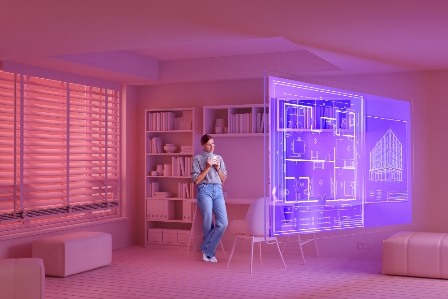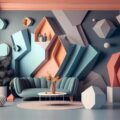Interior design is a captivating journey that transforms empty spaces into personalized sanctuaries. From the conceptualization of ideas to the realization of a dream space, the process is an art form that requires creativity, technical prowess, and a deep understanding of human preferences. Let’s delve into the intricate world of interior design, exploring every facet from the basics to the advanced, and discover how the magic happens.
Importance of Interior Design
Interior design is not just about aesthetics; it’s a blend of functionality and beauty. A well-designed space can enhance well-being, productivity, and overall quality of life. As we embark on this exploration, it’s crucial to recognize the profound impact interior design can have on our daily lives.
Overview of the Article
This article aims to guide readers through the multifaceted process of interior design, offering insights into the fundamental principles, creative processes, technological advancements, and practical considerations that contribute to creating remarkable spaces.
Understanding the Basics
Definition of Interior Design
At its core, interior design involves the strategic arrangement of elements within a space to optimize its functionality and aesthetics. It encompasses a range of factors, from color schemes to furniture placement.
Key Elements and Principles
- Color
Color sets the tone for any design. We’ll explore the psychology of colors and how they can influence mood and atmosphere within a space.
- Balance
Achieving visual equilibrium is crucial in interior design. We’ll discuss different types of balance and how to implement them effectively.
- Harmony
Creating harmony involves unifying diverse elements. We’ll delve into techniques for achieving a harmonious design that feels cohesive and pleasing to the eye.
The Creative Process
Inspiration and Conceptualization
- Mood Boards
Mood boards serve as the initial canvas for an interior designer. We’ll discuss how these visual collages help crystallize ideas and set the tone for the design.
- Sketching Ideas
Transforming concepts into tangible designs often starts with sketching. We’ll explore the importance of sketching in the creative process.
Design Development
- Choosing Materials
Selecting the right materials is a critical aspect of design development. We’ll guide you through considerations like durability, aesthetics, and sustainability.
- Furniture Selection
Furniture plays a pivotal role in defining a space. We’ll provide tips on choosing the right pieces that align with the overall design concept.
The Role of Technology
Digital Tools in Interior Design
- CAD Software
Computer-Aided Design (CAD) software has revolutionized the industry. We’ll discuss how these tools enhance precision and streamline the design process.
- Virtual Reality (VR)
Immersive experiences through VR have become integral to interior design. We’ll explore how this technology allows clients to virtually walk through spaces before they’re even built.
Budgeting and Planning
Importance of Budgeting
Effective budgeting is crucial to avoid overspending and ensure a project’s success. We’ll provide practical tips for creating and sticking to a budget.
Efficient Space Planning
Optimizing available space is an art. We’ll discuss techniques for efficient space planning, making the most out of every square foot.
Trends and Styles
Contemporary Interior Design
Explore the sleek and modern world of contemporary interior design, understanding its characteristics and how it continues to evolve.
Fusion of Styles
Mixing and matching styles can create unique and personalized spaces. We’ll guide you through the art of fusing different design elements cohesively.
The Impact of Lighting
Natural vs. Artificial Lighting
Lighting can dramatically alter the perception of a space. We’ll examine the pros and cons of natural and artificial lighting and how to strike the right balance.
Innovative Lighting Designs
From statement fixtures to smart lighting systems, we’ll explore the latest trends in innovative lighting designs that can elevate any space.
Sustainability in Interior Design
Eco-friendly Materials
With environmental consciousness on the rise, we’ll discuss the use of eco-friendly materials in interior design and their impact on sustainability.
Energy-Efficient Solutions
Discover how energy-efficient design choices contribute not only to a greener planet but also to long-term cost savings.
Overcoming Challenges
Dealing with Limited Space
Small spaces present unique challenges. We’ll provide practical tips and creative solutions for making the most of limited square footage.
Client Preferences and Adjustments
Understanding and incorporating client preferences is crucial. We’ll discuss effective communication and adjustment strategies to ensure client satisfaction.
Future of Interior Design
Emerging Trends
Stay ahead of the curve by exploring the latest trends in interior design. From technology integration to sustainable practices, we’ll glimpse into the future.
Technological Advancements
Continual advancements in technology shape the future of interior design. We’ll discuss upcoming technologies and their potential impact on the industry.
FAQs
Lighting is a crucial element in interior design as it not only illuminates spaces but also sets the mood and enhances the overall aesthetic. Understanding the interplay between natural and artificial lighting is key to creating a well-balanced and visually appealing design.
Sustainable practices in interior design contribute to environmental conservation and promote healthier living spaces. Using eco-friendly materials and energy-efficient solutions not only align with global sustainability goals but also reflect a commitment to responsible design practices.
Dealing with limited space requires creativity and strategic planning. Interior designers often utilize multifunctional furniture, clever storage solutions, and light color schemes to create the illusion of spaciousness in smaller areas.
Contemporary interior design is ever-evolving. Current trends include the use of natural materials, sustainable practices, and the integration of smart home technology. Staying updated on these trends ensures that designs remain fresh and relevant in the ever-changing landscape of interior aesthetics.
Conclusion
Mastering the art of interior design is a dynamic and rewarding journey. From understanding the basics to embracing technological innovations, every step contributes to the creation of inspiring spaces. Whether you’re a seasoned designer or a homeowner with a passion for aesthetics, this comprehensive guide aims to empower and inspire.

